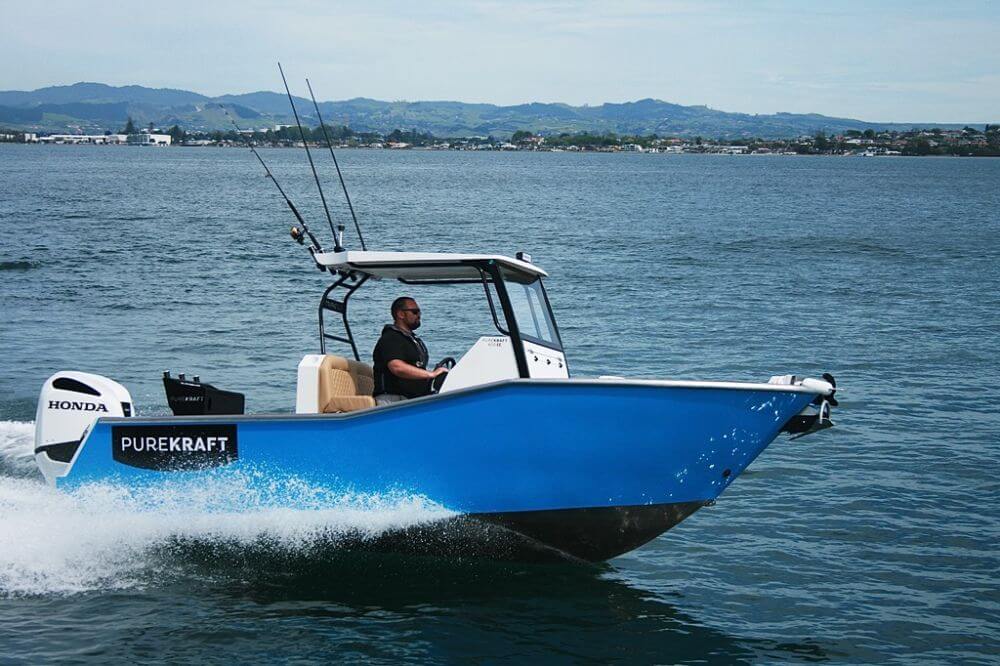DESIGNED TO FISH
Story & Images by Mike Rose
Purekraft’s design-led approach has seen the small Tauranga company really start to stand out in what is an increasingly crowded aluminium trailer boat market. Their latest offering targets those passionate about their fishing.
One could reasonably argue that all aluminium trailer boats are built primarily to fish. However, as aluminium hulls have relentlessly replaced those made from GRP most alloy manufacturers have adopted more of an “all purpose” approach.
With their latest model, Tauranga-based Hall Marine Design has resisted that urge. Their completely new Purekraft 600CC is unashamedly a fishing boat, albeit one with a fair degree of comfort.
Perhaps not surprisingly, HMD, which is run by the very passionate Jarrod Hall, adopts a very design-led approach. Every single section of all of their models has been thought through in minute detail and, wherever possible, improved.
This means their vessels are packed with clever, innovation features that, it is not hard to imagine, will quickly become incorporated into others’ designs, too.
The company’s new Purekraft 600CC (centre console) is a completely new model which, it is planned, will become the template for a range of bigger versions in the not-too-distant future.
It was also planned to be the company demonstrator. However, after being seen at a recent boat show, it was snapped up by a visitor who thought he had only gone along for “a bit of a nosy”.

Eye-catching appearance
With its egg-shell blue hull, white aluminium interior, black dash and baitboard and fawny SeaDek panels just about everywhere, the Purekraft 600 is certainly eye-catching. Even on a surprisingly busy mid-week afternoon at the Sulphur Point boat ramp there is hardly a boatie or fisher who doesn’t stop for a closer look.
Given that this is primarily a fishing boat and given, too, that most fishers spend lots of time around the transom, Jarrord and his team have put a lot of effort into its design. It is pretty obvious that they have focused on ensuring both that everything that needs to be is close at hand and, just as importantly, that there is little or no wasted space.
Pride of place is occupied by the centrally-positioned custom bait station. It is fitted with an easily removable HDPE cutting board and contains three rod holders, two drink holders and one of HMD’s trademark bottle openers (which cleverly collects the tops for later disposal). There is also a large tackle drawer complete with a push catch to hold it closed.
It is an attractive bit of kit and eminently practical although I do have one reservation: while the black HDPE board looks really classy and blends in well, it is hard not to think that a white one might work better, especially on hot summer days.
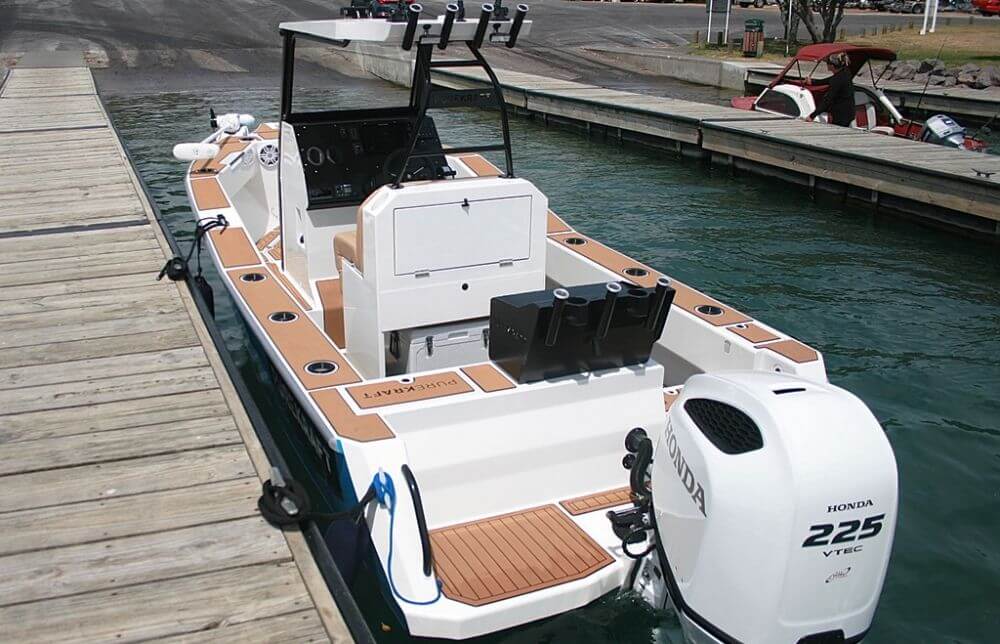
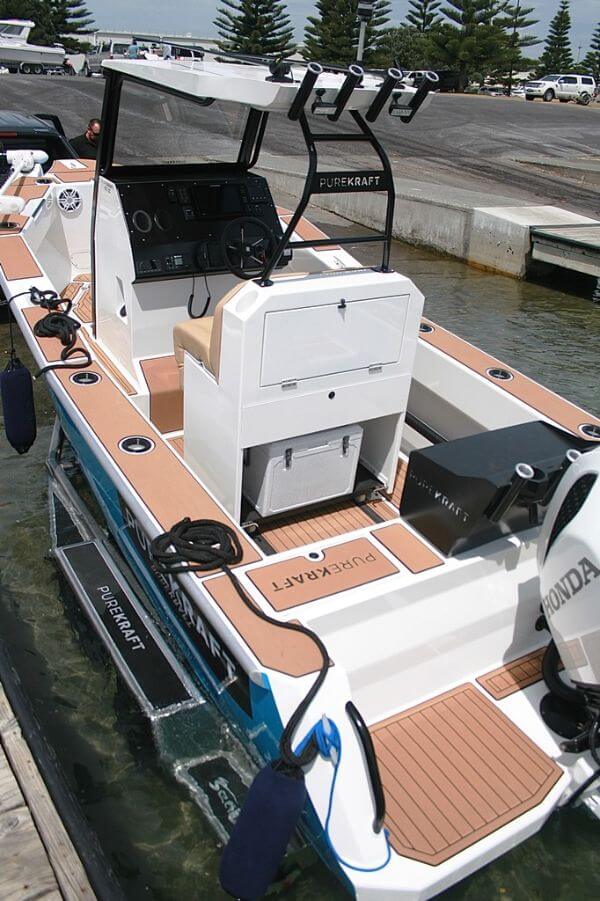
On the starboard side of the transom is the step through to the platform, along with the now standard under-step live bait well. There is also a deep, dedicated trash locker in the quarter, handily placed for those cast-off bits of fishing line, depleted refreshment containers and the like. Over on port, the transom has been dedicated to dive tank stowage, with a locker both wide and deep enough to house two standard tanks.
HMD uses stylish little icons to mark these innovative lockers and there is a similarly drawn fish measure on the aft ends of both coamings.
The main batteries, isolating switches and fuel filter are housed in their own enclosed locker safely high up on the bait station.
Along the side decks, between the panels of SeaDek, are another HMD innovation: combination rod and drink holders. There are three per side and they come complete with removable and replaceable insets.
The long side lockers are fitted with calf-protecting hard plastic panels and feature handy toe kicks to help those wrestling with the more substantial types of fish.
A self-draining underfloor locker provides a great place to stow the catch once on board.
The innovations continue out back, too. The apparently missing boarding ladder is actually recessed into the platform, protected from inadvertent opening by its own catch and clearly marked with a graphic. Compact lockers on the sides of the platform make handy use of otherwise dead space and are ideal for stowing mooring lines, the propeller flag and the like.

More than a seat
One of the 600CC’s most striking features is its console seat module. Designed to get the skipper and a mate up high (for better visibility) it provides comfortable seating for two on deep vinyl-covered squabs of a similar hue to that of the SeaDek panels. It also features a large handy locker at the rear (used by Jarrod mainly for stowing the vessel’s cleaning products) with its open hatch cover acting as a handy table, a good-sized drawer (ideal for lifejacket stowage) and even more stowage under the bench seat squabs.
There is also, under the module, a substantial 87-litre chilly bin. This sits on its own shelf which, when needed, rolls back on a set of casters. It also comes with its own 12v outlet for those who wish to step up to an electric fridge.
The back of the seat console also provides the base for the bimini’s rear supports and the edges have been cleverly angled to accommodate more of those combination drink/rod holders.
For those at the steering station there is a choice of footrests: a large SeaDek-covered one at the base of the helm console or a metal bar back under the bench seat.
Rather than being a part of the deck mould, both the seat and deck modules are separate bolted-on units. This allows them to be created and completed out of the boat, improving construction efficiency and saving time.
Similarly, the various screens, instruments and gauges have been placed on an inset before this was bolted onto the console. Again, this keeps this part of the operation separate and speeds up the building process.

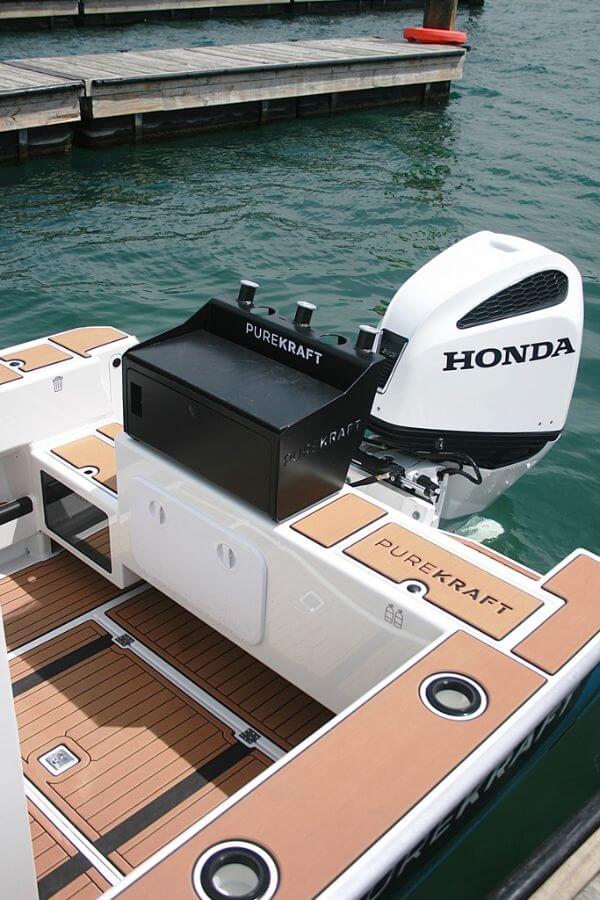
Linking the various electronics is a Humminbird Solix12 MFD which, among other things, gives total fingertip control of the MinnKota electric trolling engine on the bow. Alongside is the digital control panel for the Honda 225hp, the CZone DC panel (also linked to the Humminbird) and the controls for the Maxwell drum winch and the Lenco trim tabs. There is also a Scanstrut Rokk cellphone holder and charger, a waterproof USB charger, a Simrad VHF, a Fusion stereo and two stylish drink holders. The steering is hydraulic Ultraflex “fly-by-wire”.
The inside of the console, accessed either through a hatch or by tilting the entire unit aft, houses the batteries and mechanics for the MinnKota, along with a substantial stowage area that could, if required, be used to house a toilet.
Fishing bow
The 600CC’s bow is, like the rest of the vessel, covered with SeaDek anti-skid panels. There is area ideal for use as a casting platform and a shallow floor locker under this. The bow area also features recessed hand rails, more of those combination holders and access to the drum winch and its rode. This is connected to a clever retractable anchor stem that sits flush against the stem when not in use and automatically extends when the anchor is deployed.
A special flat area for the MinnKota has been built into the port bow area.
Other notable additions are the twin backward-facing Fusion speakers, linked to another pair at the rear of the bimini and the handy spring cleats on the side decks alongside the console.
There is also superb Lumitec LED lighting throughout. This includes a forward facing and twin aft facing spotlights, red/white lights above the steering station and mood lighting around the edges. The Fusion speakers, too, contain their own colour-changing LED lights, able to pulse in time to the music.
Smooth and comfortable
Having now experienced a number of Purekraft models, it came as no surprise that the 600CC performed exceptionally well in both the sheltered harbour waters and the more boisterous ones outside.
At the top end of the model’s recommended horsepower range (150-225hp), the four-stroke Honda 225 gets the 600 up onto the plane in a hurry and delivers predictable power variation throughout its range. Tight turning is not a problem and neither was the steadily increasing swell outside in the Bay of Plenty. The run up to an area between Karewa and the Bowentown entrance to Tauranga Harbour was comfortable even in the somewhat confusing combination of swell and chop.
Softbaiting while using the electric engine to control the drift proved remarkably easy with just a few touches on the Humminbird MFD required to deploy the motor, set the angle to the sea and the revs, and then return the motor to its horizontal position when finished.
On our way up and later down the coast, we sat comfortably on around 27-29 knots while pulling around 4000-4500rpm. The ride was smooth and enjoyable and was especially impressive on the return journey when the increasing “downhill” swell might have been expected to show up any issues with the vessel’s handling.
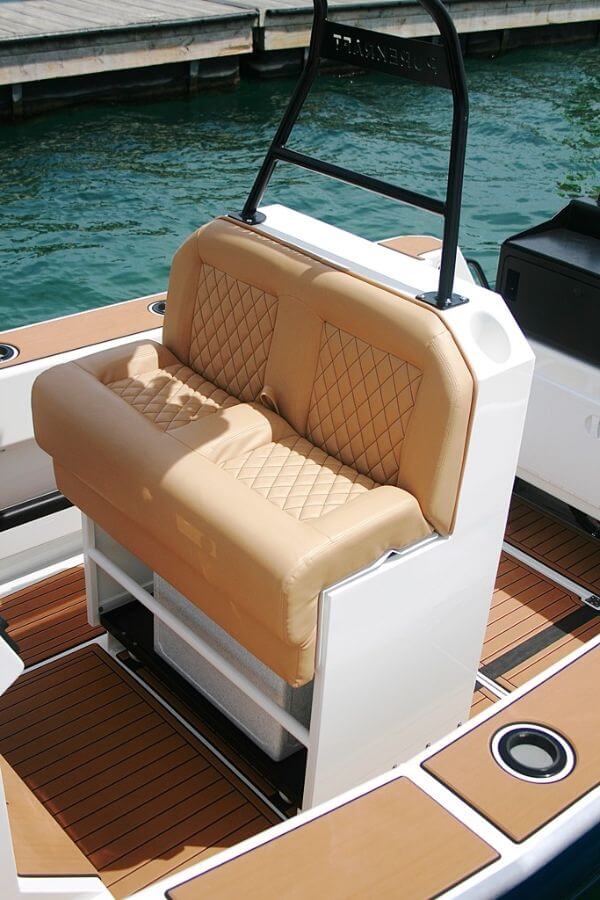

Summary
HMD’s design-led approach is certainly paying big dividends. In just a few short years, they have gone from a company primarily creating kitset aluminium boats for DIYers to finish at home (and completing the odd demonstrator) to a true aluminium boat manufacturer with a range of both production and customised models.
This being the third Purekraft I have had the pleasure to review, the things that really stand out and have been common to all three are the high quality of the finish and the numerous innovative design features. From a consumer’s point of view, the good news is that those clever touches just keep coming. This model has more than the previous one and the next one will no doubt have more still.
For Hall Marine Design, the future not only looks assured, it also looks pretty damn exciting.
Specifications
- Model & Model: Purekraft 600 Centre Console
- Price as tested: $145,000
- Priced from: $97,500
- Type: Centre Console
- Construction: Aluminium, 6mm hull
- LOA: 6.15m (including fairlead)
- Beam: 2.33m
- Deadrise: 18deg @ transom
- Height on trailer: 2.94m
- Trailerable weight: 2050kg (with 200L fuel)
- Test Power: 225hp
- Power options: Outboard
- HP Range: 150-225hp
- Fuel Capacity: 200L
- Trailer: Purekraft alloy


